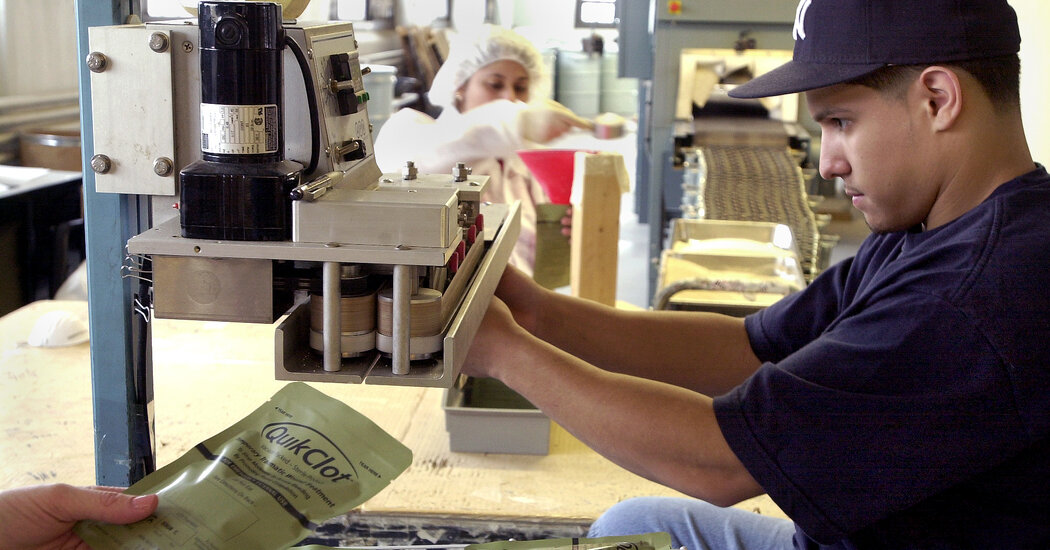Blood
A Fight to Save Soldiers, From the Lab to the Battlefield
“In the Blood” traces how an engineer and a salesman took on military leaders and Big Pharma to get a revolutionary clotting agent to those in dire need.
IN THE BLOOD: How Two Outsiders Solved a Centuries-Old Medical Mystery and Took On the U.S. Army, by Charles Barber
Reading, like riding shotgun with a stranger, is an act of faith, whose first moments matter. An accurate, judicious beginning often allows us to settle back and enjoy the ride, whereas an early slip or swerve means we might be white-knuckling the rest of the journey. Charles Barber’s “In the Blood” treats a consequential topic, and contains moments of real insight, drama and humor. Trouble is, Barber opens with several omissions and slights that left me on edge for the balance of the book.
Barber begins his story about catastrophic bleeding and the urgent search for a cure, appropriately enough, in the savage battle for Mogadishu in 1993. But he misstates the timing of the ill-fated U.S. raid and muffs the mission’s actual goal: to seize two of the Somali warlord Mohamed Aidid’s lieutenants, not Aidid himself. More glaringly, the Army Rangers described on the raid actually played a supporting role to commandos from Delta Force, which Barber never mentions. In a book dedicated to “the warriors,” such an oversight seems incongruous.
Yet I wanted to trust this book, because it tells an important story in vivid, engrossing terms. Though hemorrhage is a leading cause of death in both war and peacetime, we learn, the techniques for stopping it haven’t improved significantly for millenniums. Barber explores the mysteries of the “coagulation cascade” — during which diverse proteins activate in intricately choreographed sequence to facilitate clotting — as well as the “lethal triad” of hypothermia, acidosis and coagulopathy (impaired clotting) that can send the body into shock.
We watch a surgeon at a Navy hospital in Bethesda slit the femoral arteries of a herd of 700-pound pigs, then apply different hemostatic agents to the spurting wounds, to see which substance stops the bleeding best. Most products, backed by biotech and medical companies, fail: The poor beasts bleed out. But zeolite, a simple mineral with hitherto unknown hemostatic properties, saves their bacon every time.
Barber’s earlier books feature persistent, plucky outsiders who strive to change the world, and he finds two more likely subjects in the men who brought zeolite’s lifesaving properties to light. Frank Hursey is the brilliant, nerdy engineer who discovers that this cheap, highly porous mineral, used by industry to absorb radiation, chemicals and bad odors, also happens to accelerate clotting, by mopping up water in the blood and thereby concentrating its coagulation agents. (Later Hursey finds that another inexpensive mineral, kaolin, works even better.)
Barely anyone pays attention to Hursey’s discovery until he partners with Bart Gullong, a down-on-his-luck salesman who rebrands Hursey’s invention “QuikClot” and persuades a military scientist to try it out on people. Hursey and Gullong are soon befriended by iconoclasts within the armed forces medical establishment, more of Barber’s appealing, quirky, determined Davids, who together take on two of the biggest Goliaths around: the military-industrial complex and Big Pharma.
Ultimately QuikClot Combat Gauze triumphs over a string of products developed by deep-pocketed rivals, and changes a key medical paradigm, not only by offering a revolutionary new bleeding remedy, but by placing it in the hands of people who can put it to use where the bleeding actually starts: “police officers, E.M.T.s, adventurers, soldiers, hikers, and moms and dads.”
Barber is at his best when he describes the sinister hive-mind of the Pentagon, that “fatal collision of the arrogance, massive budgets and unchecked power structure of Army medicine,” which time and again leads the military to subordinate the safety of its troops to the welfare of military contractors selling overpriced, ineffectual war bling.
He evokes the psychic force field of money and power as it warps the ethics even of distinguished, principled doctors and soldiers. And he captures the agonizing moment when truth tellers within an inflexible bureaucracy feel their organization turning on them, with the virulence of the immune system turning on a deadly germ.
His devotion to his characters is obvious throughout. He cares deeply about these people, and soon we do, too. Yet his portraits often seem constrained within narrow, shopworn categories. “In the Blood” is a whistle-blower story, an idea-that-changed-the-world story, a last-chance-at-redemption story and a rags-to-riches-American-dream story.
It is, ad nauseam, a brothers-in-arms story, whose likable soldiers revile the self-important brass but are devoted to “the kid in the ditch” — the common soldier in harm’s way. These crusty warriors address one another in ringing tones: “Son, I know you just came back and I can smell the combat on you,” the short, pugnacious maverick Marine Corps medic Tommy Eagles tells the short, pugnacious maverick Navy commander Timothy Coakley — squint and they could be the same character. “I’ve been there. I will pray for you.”
Barber seems so fond of certain figures that, at the close of his tale, he stops being critical of them. He reports that Hursey and Gullong cash out by selling Z-Medica, the company that manufactures their beloved QuikClot, to a private equity firm; Gullong spends his money on a beachfront property, a Florida condo and a million-dollar yacht, while Hursey bankrolls a university building with his name on it.
In 2020 the private equity firm flogged Z-Medica to a major medical device company — a company that, though the book doesn’t say so, has faced legal challenges of its own.
Tom Mueller’s latest book, “How to Make a Killing: Blood, Death and Dollars in American Medicine,” will be published in August.
IN THE BLOOD: How Two Outsiders Solved a Centuries-Old Medical Mystery and Took On the U.S. Army | By Charles Barber | 304 pp. | Grand Central Publishing | $29

